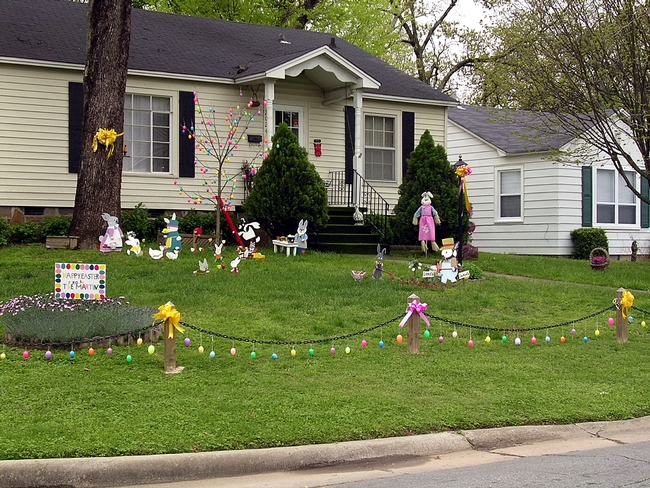Most of us grew up with a lawn. For many of us, mowing the lawn was a part of our weekly chores growing up; yellow spots were treated like a black mark, and a dandelion popping up was like a declaration of war. We have all been brought up in or have participated in lawn care culture in one way or another, without many of us having much of an idea why. Why is the lawn so quintessential in our culture?
The concept of a lawn didn't really exist until relatively recently. Grass was used in landscapes as a frame for more interesting fare, like in the Gardens at Versailles, using it as the tapis vert or green carpet. In fact, before the 18th century, the word lawn itself didn't mean what it does today. The word laune meant a glade or clearing in a forest. Later, as we domesticated livestock, it came to mean more of a pasture where cattle would graze. The concept of the word "lawn" being used to mean a manicured grassy area was first recorded in 1733 in Europe. When lawns were featured in landscapes at the time, they were a status symbol of great wealth. You had to be wealthy to own land, and even wealthier to own land that generated no profit and just looked pretty.
A grass lawn as a landscape feature is largely the influence of "England's Greatest Gardener," Lancelot Brown, commonly known by his nickname "Capability" Brown, because he would often tell his clients that their property had the capability for improvement. Capability was a renowned landscape architect, known for a radical new style at the time called a "gardenless garden" as opposed to the patterned gardens of the day. The hallmarks of Brown's gardenless style were big undulating seas of grass leading straight up to the manor, with scattered plantings of trees and man-made lakes. He designed the landscapes of over 170 of the finest estates in England, making him one of the most prolific and influential landscape architects to come out of Europe. When the American aristocracy (many of them founding fathers) visited these estates, they were enthusiastic about what they saw and incorporated lawns into their estates back home in places like Washington's Mt. Vernon and Jefferson's Monticello. Thus, lawns as a landscape made it to a fledgling United States.
As the United States began to grow both in population and economically, the country took on a decidedly urban look with cramped housing for the new immigrants flooding into the land of opportunity. The European notion of getting away to the countryside couldn't really be practiced because we didn't have countryside; we had a wild, rugged frontier, which had its charms but being a relaxing place to have a picnic wasn't one of them. In response, there was a shift in the ethos of American landscape architecture. There was a growing thought that we wanted our landscapes to be open, welcoming, and ample. Around the same time, "The Father of American Landscape Architecture," Frederick Law Olmsted, designed Central Park in New York. His design heavily featured large grassy areas, strategic plantings of trees, and man-made lakes. Sound familiar? This work influenced other communities across the country to follow suit and design their public spaces with turf as a prominent feature.
Later in 1868, Olmsted would have the opportunity to work on the designs for the first planned suburb in Riverside, Illinois. He required that the houses be set back 30 feet from the road for… you guessed it, a lawn. This suburb served as an example for more housing developments not only because it fit into the aesthetic philosophy of landscape architecture at the time but it was also convenient for building architects and city planners. When an architect is drawing up plans for a whole subdivision of beautiful and functional homes and there's blank space on the page, it's easier to fill it in with a generic lawn than to draw up garden plans.
It wasn't until a hundred years later in 1950s-60s America that suburbs took off. Amid civil unrest taking place in urban centers across post-war, post-depression America, the latest generation of homeowners were ready for a quiet life away from the city, but close enough to have the modern consumer conveniences. The American Dream had shifted from the homestead to a white picket fence around one of Olmsted's lawns. Having great curb appeal was how you kept up with the Joneses and a tight lawn became an expectation. More importantly, those homeowners raised the largest generation from the largest baby boom that this country had ever seen within that culture, ensuring that the shared hobby of lawns would persist.
The lawn became an American icon and a symbol of communal identity and pride. Generations later, lawn care is a billion-dollar industry and Americans still love their lawns.
